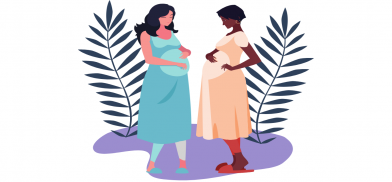Bangladesh model for reducing maternal mortality being replicated globally
Bangladesh’s Kapasia sub-district is gaining global recognition for achieving zero maternal mortality over the last three years

Bangladesh’s Kapasia sub-district is gaining global recognition for achieving zero maternal mortality over the last three years.
Part of Gazipur district, Kapasia saw eight expectant mothers die in 2017, according to Prothom Alo.
On December 4, 2017, the Upazilla (sub-district) health complex began the initiative to check maternal mortality in the area.
In 2018, out of 6,300 expectant mothers, four died. Since then, there has not been a single maternal death. Last year, there were as many as 6,500 expectant mothers.
Central to the initiative is a software database ‘Gorbhobotir Aina’ (roughly translated as expectant mother’s mirror).
The database includes 27 different components of information including the risks faced by an expectant mother, her age and so on. This is accompanied by a health manual, ‘Gorbhobotir Goina’ (expectant mother’s ornament). These two tools are being used to conduct the entire programme.
Kapasia’s local member of parliament Simeen Hossain is the patron of this programme aimed at freeing Kapasia of maternal mortality.
“Before I was elected to parliament, I would go to every village and speak to the mothers. They were not aware of many things and did not get proper healthcare either. The situation has changed radically after this software was made and other measures taken,” the MP told the Bengali language paper.
The entire programme is coordinated by the Kapasia sub-district family planning officer Md Abdur Rahim.
At Rahim’s small office, he pointed to the data on the dashboard of his computer. This was ‘Gorbhobotir Aina’, The data showed 1,169 expectant mothers in Kapasia at the time, of whom 636 were risky cases.
According to Rahim, the software identified risky cases automatically based on certain data like whether the expectant mother was below 20 years old, or over 35, or under 4ft 10 inches in height, or if it was her first pregnancy, or if she had a negative blood group.
If an expectant mother dies within the time of conceiving to 42 days after delivering the child, it is considered maternal mortality, unless the death is caused by any other unrelated accident.
Bangladesh has a maternal mortality rate of 196 per 100,000 live births. According to the UN’s Sustainable Development Goals (SDG), the maternal mortality rate must be brought below 70 by the year 2030.
Rahim said the two major causes of maternal deaths are excessive bleeding during childbirth and eclampsia, though such deaths can be prevented by ensuring a minimum four checkups before childbirth, delivery of the child by a skilled attendant or midwife, and proper ante-natal care. Basically these factors have been included in the model to free Kapasia of maternal mortality.
The programme is now running in 11 unions of the sub-district. The expectant mothers are given a form with 37 questions. The health workers enter the information into the database with the help of the software.
The heath workers then schedule a visit to the health centre for the expectant mother. Three days before the scheduled visit, a reminder is sent by SMS to the expectant mother’s mobile phone. The message includes the mobile number of the health worker, who can be consulted on any issue. On the morning of the visit, a voice call is sent by mobile phone, reminding the expectant mother of the visit.
Every expectant mother is given the manual ‘Gorbhobotir Goina’, which contains all vital information in a lucid and understandable format.
Nothing is charged for the visit and tests.
A non-government organisation, Innovation for Poverty Action, conducted a survey in 2017 and 2019 on expectant mothers in Kapasia sub-district. It revealed that the ‘maternal mortality-free Kapasia’ programme has increased awareness among expectant mothers.
A fund called Humanitarian Aid has been set up to arrange the required funds for this programme. Every day one taka (Bangladesh currency equivalent to 0.012 USD) from each of the 1,700 government officers and employees of Kapasia sub-district goes into this fund, according to Prothom Alo.
The funds are used to send the SMS, voice calls, conduct tests and checkups and, in some cases, Caesarian -section surgery too.
The Kapasia model is now being replicated nationally in Bangladesh by the health and family planning ministry.
Partners in Population and Development (PPD), an initiative involving 27 countries with large population, is implementing a project based on the Kapasia model and funded by United Nations Population Fund to reduce maternal mortality.









Post a Comment